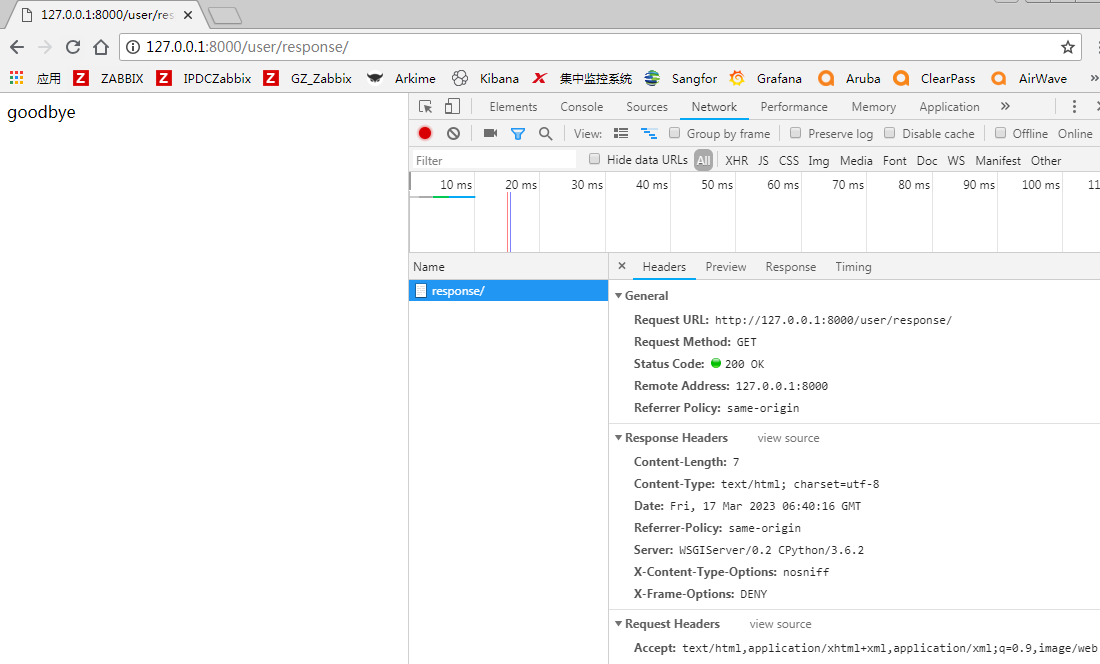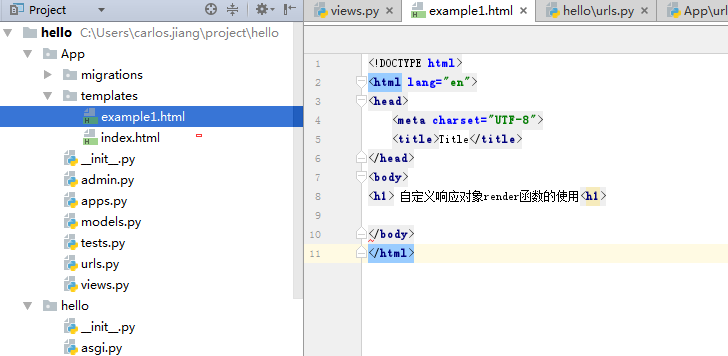自学Python之路-django视图--响应对象HttpResponse、JsonResponse、render、重定向redirect
响应对象主要有三种形式:
- HttpResponse()
- render() 本质也是返回HttpResponse()
- redirect() 重定向
响应对象 HttpResponse()
Django服务器接收到客户端发送过来的请求后,会将提交上来的这些数据封装成一个 HttpRequest 对象传给视图函数。那么视图函数在处理完相关的逻辑之后,也需要返回一个响应对象给浏览器。 HttpResponse对象由程序员创建并返回。
| 属性 | 说明 |
| content | 字节字符串,返回的内容。 |
| charset | 字符编码 |
| status_code | http状态码 |
| content_type | 指定输出的MIME类型,默认为text/html。浏览器会根据这个属性,来显示数据。如果是text/html,那么就会解析这个字符串,如果 text/plain,那么就会显示一个纯文本。 |
常用的状态码status_code如下:
| 状态码 | 含义 |
|---|---|
| 200 | 响应成功 |
| 301 | 永久重定向,Location属性的值为当前的URL |
| 302 | 临时重定向,Location属性的值为新的URL |
| 404 | URL不存在 |
| 403 | 未授权访问 |
| 500 | 内部服务器报错 |
| 502 | 网关错误 |
| 503 | 服务不可用 |
def handle_respone(reqest):
res = HttpResponse("响应对象")
res.content = b'goodbye'
res.charset = "utf-8"
res.content_type = "text/html"
return res
urlpatterns = [
# 响应对象
path('response/',views.handle_respone,name='respone'),
]

1 响应对象JsonResponse
- JsonResponse是HttpResponse的子类,用于向客户端返回json的数据。一般用于ajax请求
- 用来对象 dump 成 json字符串,然后返回将 json 字符串封装成Response 对象返回给浏览器。并且它的Content-Type缺省值是 application/json
from django.http import JsonResponse # 导入包 class JsonResponse(data, encoder=DjangoJSONEncoder, safe=True, json_dumps_params=None, **kwargs)
参数:
- JsonResponse对象的默认Content-Type头部设置为application/json
- data:应该为一个dict实例。如果safe参数设置为False,它可以传递任何JSON对象进行序列化(否则,只允许dict实例)
- encoder:缺省是 django.core.serializers.json.DjangoJSONEncoder,用于序列化data
- 布尔参数safe:默认为 True。如果设置为False,可以传递任何对象进行序列化(否则,只允许dict实例)。如果safe为True,而第一个参数传递的不是dict对象,将抛出一个TypeError
- json_dumps_params是一个字典,它是在生成响应时,传给json.dumps()的参数
from django.http import JsonResponse def handle_respone(request): return JsonResponse({'name':'carlos'}) #对字典,可以返回json字符串

def handle_respone(request): return JsonResponse([1,2,3,4,5,6,7,8,9,8,8,8,8,8,],safe=False) # 如果参数不是字典,将参数设置safe=False

2 响应对象 render()函数
- 一般的render函数返回,render只是HttpReponse的包装,还是会返回HttpReponse的对象。
- render主要是将从服务器提取的数据,填充到模板中,然后将渲染后的html静态文件返回给浏览器。
- 这里一定要注意:render渲染的是模板。
def render(request, template_name, context=None, content_type=None, status=None, using=None): """ Return a HttpResponse whose content is filled with the result of calling django.template.loader.render_to_string() with the passed arguments. """ content = loader.render_to_string(template_name, context, request, using=using) return HttpResponse(content, content_type, status)
参数:
- request: 是一个固定参数
- template_name: templates中定义的文件,注意路径名。比如:“templates/polls/index.html”, 则参数这样写:“polls/index.html”
- context: 要传入文件中用于渲染呈现的数据,一组字典的值添加到模板中。默认情况下,这是一个空的字典。
- content_type: 生成的文档要使用的MIME 类型。默认为DEFAULT_CONTENT_TYPE 设置的值。
- status: http的响应代码,默认是200。
- using: 用于加载模板使用的模板引擎的名称。
def studentlist(req): for key in req.GET.lists(): print(key) allstudent = Student.objects.all() return render(req,'studentlist.html',context={'data':allstudent})
常用的方法:
- write(content) 设置内容 == obj.content
- set_cookie() 设置cookie
- delete_cookie() 删除cookie
以下举例:
def handle_respone(request): # render 返回响应对象 res = render(request,'example1.html') return res


3 响应对象 重定向redirect
- 当浏览器向server发送一个请求,要求获取一个资源时,在server接收到这个请求后发现请求的这个资源实际存放在另一个位置,于是server在返回的response中写入那个请求资源的正确的URL,并设置reponse的状态码为301(表示这是一个要求浏览器重定向的response),当client接受到这个response后就会根据新的URL重新发起请求。
- 重定向有一个典型的特症,即:当一个请求被重定向以后,最终浏览器上显示的URL往往不再是开始时请求的那个URL了。这就是重定向的由来。
- HttpResponseRedirect是HttpResponse的子类,可以完成页面的重定向,当执行完特定动作或出现错误时,我们会希望执行的页面,如果判定用户没有登录则转到登录页面。
- 重定向可以直接写成redirect,redirect是HttpResponseRedirect的简写。
- HttpResponseRedirect只支持硬编码url,不能直接使命名url,在使URL命名时,我们需要先通过URL反向解析方法reverse先对命名URL进行解析,然后再使HttpReponseRedirect定向。
使用时需要导入: from django.http import HttpResponseRedirect
3.1 不带参数重定向
#views代码: from django.http import HttpResponseRedirect from django.shortcuts import render,HttpResponse,redirect def index(request): return HttpResponse("首页") def handle_redirect(request): #HttpResponseRedirect重定向到指定路由地址,参数就是路由
#redirect是HttpResponseRedirect缩写
return HttpResponseRedirect("/user/")
#APP\urls 子路由代码:
urlpatterns = [
path('', views.index, name='index'),
# 重定向
path('red/',views.handle_redirect,name='red')
]
浏览器中输入http://127.0.0.1:8000/user/red/ ,会直接重定向至http://127.0.0.1:8000/user/

3.2 带参数重定向
#APP\urls.py 子路由代码 path('repath/<int:num>/', views.repath), re_path(r'^parameter/(?P<num1>\d+)/(?P<num2>\d+)/$',views.parameter), #views.py 代码 def repath(req,num): return redirect("parameter/3/5") def index(request): return HttpResponse("首页") def parameter(req,num1, num2): return HttpResponse("num1={},num2={}".format(num1,num2))
可以直接重定向到其他网页:
1 2 3 4 5 6 7 8 9 | #views.py 代码def handle_redirect(request): return redirect("https://www.baidu.com/")#APP\urls.py 子路由代码urlpatterns = [ path('', views.index, name='index'), path('red/',views.handle_redirect,name='red'),] |
浏览器中输入http://127.0.0.1:8000/user/red/ ,会直接重定向至百度www.baidu.com
3.3 反向解析
由应用命名空间,name来确定路由。。。根据namespace 和 name 查找真实路径:
- namespace 在根url 包含子url时指定
- name 在具体的函数后指定子url指定
# urls.py中 app_name = 'App' # namespace 命名空间 urlpatterns = [ path('', views.index), path('para/<int:num1>/<int:num2>/'), ] #python代码中写法 def repath(req): # res = reverse("App:index") # print(res,type(res)) # return redirect(res) # path中参数或re_path中的位置参数,args可以是列表或元组 # return redirect(reverse("App:para",args=(1,2))) # re_path中命名组,带关键字参数 return redirect(reverse("App:para",kwargs={'num1':1,'num2':3}))
render和redirect两者区别:
- 第一,假如render返回一个登陆成功后的页面,刷新该页面将回复到跳转前页面。而redirect则不会
- 第二,如果页面需要模板语言渲染,需要的将数据库的数据加载到html,那么render方法则不会显示这一部分,render返回一个登陆成功页面,不会经过url路由分发系统,也就是说,不会执行跳转后url的视图函数。这样,返回的页面渲染不成功;而redirect是跳转到指定页面,当登陆成功后,会在url路由系统进行匹配,如果有存在的映射函数,就会执行对应的映射函数。
.......
作者:CARLOS_CHIANG
出处:http://www.cnblogs.com/yaoyaojcy/
本文版权归作者和博客园共有,欢迎转载,但未经作者同意必须保留此段声明,且在文章页面明显位置给出原文链接。
posted on 2023-03-10 07:21 CARLOS_KONG 阅读(683) 评论(0) 编辑 收藏 举报




【推荐】国内首个AI IDE,深度理解中文开发场景,立即下载体验Trae
【推荐】编程新体验,更懂你的AI,立即体验豆包MarsCode编程助手
【推荐】抖音旗下AI助手豆包,你的智能百科全书,全免费不限次数
【推荐】轻量又高性能的 SSH 工具 IShell:AI 加持,快人一步
· TypeScript + Deepseek 打造卜卦网站:技术与玄学的结合
· Manus的开源复刻OpenManus初探
· AI 智能体引爆开源社区「GitHub 热点速览」
· 三行代码完成国际化适配,妙~啊~
· .NET Core 中如何实现缓存的预热?